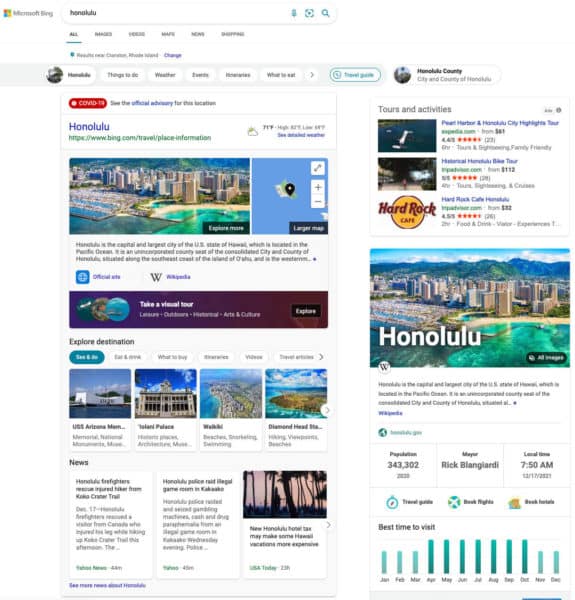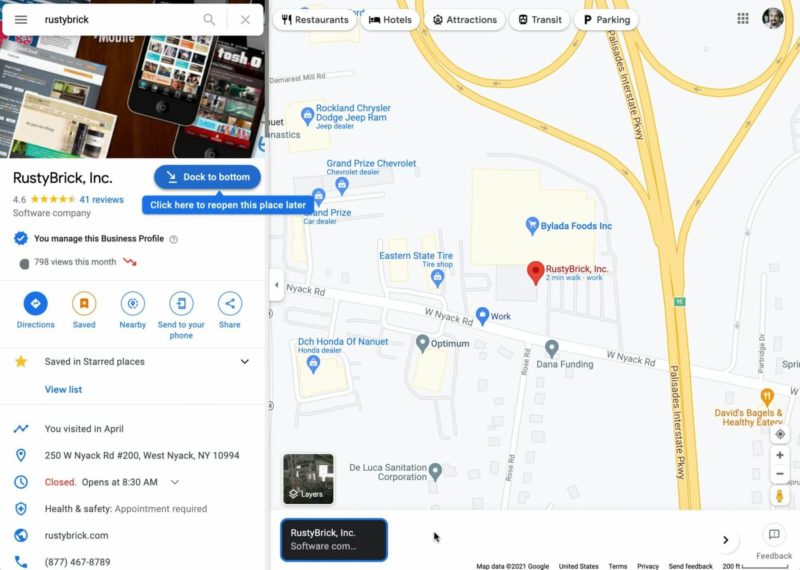Bing launches travel-oriented results pages and a trip-planning hub
For years, search engines have been expanding their travel offerings to the dismay of online travel agencies — Bing’s new travel features only continue that trend.
The new destination search results pages are visual-heavy, which may make them more compelling to users. Many of the search features, like hotel results or the “Explore destination” carousel, take users to other Bing properties. And, since they’re more visually compelling than a standard search listing, it may be even more difficult for OTAs to compete in the search results.
The new Travel Guide is quite similar to Google’s travel portal, but both Bing’s Travel Guide and its destination search results seem to be designed for discovery, which may help it serve customers that are in the initial stages of their planning.
Revamped destination search results. Searching for a destination on Bing may trigger its new travel search experience (shown below for the query “Honolulu”).

This search results page format includes a large search feature containing a link to the Travel Guide (more on that below) for the destination, as well as carousels for local attractions and news. The best time of the year to visit and hotel listings are also prominent on the page, along with Tours and activities ads.
Read more: Bing launches travel-oriented results pages and a trip-planning hub
How to optimize your site for better findability
“You wouldn’t build a house without having a strong foundation,” Niki Mosier, head of SEO and content at AgentSync said, “And you shouldn’t build a website without having a strong foundation either, and without constantly making sure that foundation is strong and that there are no cracks in it.”
Optimizing the architecture of your site can help search engine crawlers find and index your content, which enables them to show those pages to users in the search results. It can also help send link authority around your site as well as make it easy for visitors to find what they’re looking for.
In her session at SMX Create, Niki Mosier shared the strategies she uses to ensure that the foundations of her site are solid and identify opportunities for greater search visibility.
Crawl budget analysis
Crawl budget refers to the number of URLs per site that Googlebot (or any other search engine crawler) can and wants to crawl.
“Every website gets a crawl budget, which can vary depending on the size of the site and the frequency that new content is being published on the site, so having an idea of what a website’s crawl budget is can be really beneficial in making informed decisions on what to optimize,” Mosier said.
Conducting a crawl budget analysis enables you to get a more comprehensive view of:
- How your website is being crawled. “If you identify that Googlebot is the client, you can use log file analysis to find out how Googlebot is handling the URLs on your site [and] if it is crawling any pages with parameters,” she said.
- How fast your site is. While there are many tools that can tell you how fast your server reacts, a log file analysis shows you how long it’s taking for a bot to download a resource from your server.
- Indexing problems. “Getting into the log files can really show us whether bots are having trouble downloading a page fully,” Mosier said.
- How often a URL is being crawled. The crawl frequency can be used to figure out if there are URLs that a search engine crawler should be crawling but isn’t, or vice versa.
- Crawling problems. This tactic can also reveal when a crawler is encountering 404 errors or redirect chains, for example.
“When it comes to actually doing crawl budget analysis, there’s a couple of tools that are helpful,” Mosier said, recommending ScaremingFrog’s Log File Analyser, Microsoft Excel and Splunk.

Read more: How to optimize your site for better findability
How to gain SEO insights using data segmentation
Recognizing patterns is a major part of successful SEO strategies, yet it can seem daunting with the sheer amount of data available. Murat Yatağan, the consultant for growth and product management at Brainly, recommends marketers address these issues using data segmentation tactics.
“You need to focus on generating insights based on patterns that you can recognize,” said Yatağan in his presentation at SMX Next. “An important part of a successful issue strategy is relying on these patterns that you have recognized — these things are telling you a story.”
Yatağan suggests marketers use one of two data segmentation tactics — with a developer’s help if needed — to serve as the foundation for your SEO strategy: custom scraping using Regex/Xpath or segmentations post-crawl.
“I segment data by traffic,” he said. “It’s organic traffic along with the crawl information that I gathered because these two [metrics] enable me to triangulate the data about the website, so it shows me some patterns.”
Here are four common patterns Yatağan recommends marketers look for to gain insights from their data segments.
Read more: How to gain SEO insights using data segmentation
Google Maps adds dock to bottom
Google recently added a feature to Google Maps to dock local listings to the bottom of the map interface. When you search for a business, you can click the “dock to bottom” button. That will trigger Google Maps to move that local listing to the footer of the map interface so that searchers can reopen the place later.
What it looks like. Here is a screenshot of this feature, that I’ve been seeing for the past week for some of my local maps queries:

Use case. Searchers can use this to dock numerous places to the bottom of the page so they can organize a trip. It can also be used when you are searching for a local business and multiple options interest you, you can dock the ones you like and dig into which one you prefer to go to. If you are a foodie, you can dock a bunch of restaurants to check out later. There are many use cases.
Read more: Google Maps adds dock to the bottom
YouTube to automatically link to places mentioned in videos

